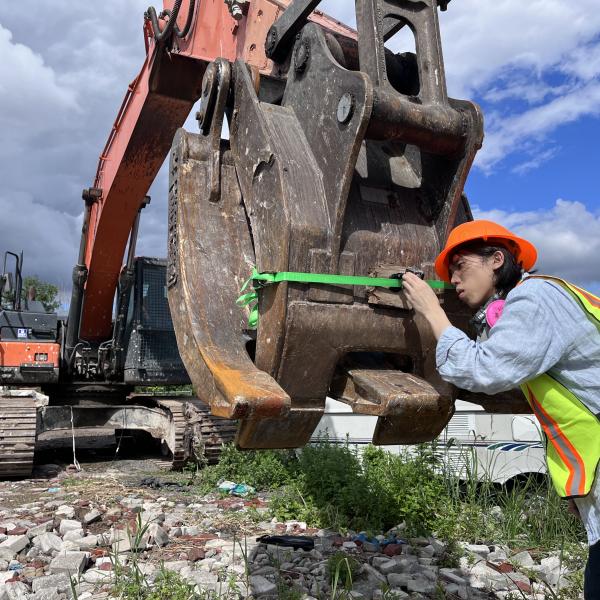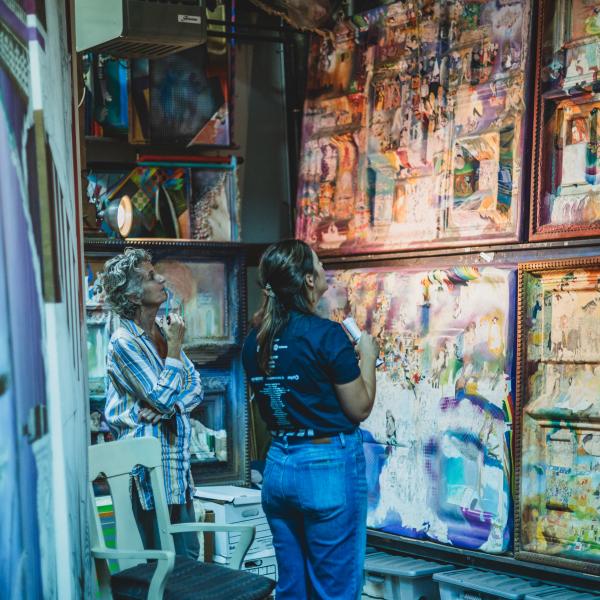Building the Power of Arts and Culture

NEA Chair Jackson at Taller Comunidad La Goyco in Puerto Rico, where local nonprofit Estuario has held artist residencies. (left to right) Adriana García, a previous artist-in-residence at Estuario; Evelyn Huertas, M.S., U.S. EPA Region 2, Caribbean Environmental Protection Division; Chair Jackson; Brenda Torres Barreto, Executive Director of Estuario; and Mariana Reyes, Executive Director at Taller Comunidad La Goyco. Photo by Katherine Bray-Simons, National Endowment for the Arts
At their most powerful, arts and culture do not exist in a silo, separate from all other dimensions of our society. We are able to unleash their power when we position the arts in all facets of our daily lives, communities, towns, and cities. This includes the development of our built environment. Integrating design, creativity, artistic sensibility, and imagination helps to create physical infrastructure that can impact and nourish our sense of belonging and social well-being, which are critical components of thriving and healthy communities. Trained as an urban planner, I recognize the importance of the built environment in shaping quality of life and outcomes in many ways. Elevating the arts in our built environment contributes to fostering social cohesion, making opportunity accessible to all, and bolstering our democracy and civic life. In the same way that thoughtful infrastructure design has the potential to deliver on these benefits to communities in equitable ways, it can also create disparate impacts across and within communities. Historically, past large-scale federal infrastructure projects—our nation’s highways, bridges, and railroads—served as conduits of connectivity and convenience for some communities. In other communities, particularly in communities of color, many of these projects sliced through neighborhoods and neglected community needs, resulting in social and cultural division, environmental injustice, health disparities, decreased economic opportunity, racial segregation, cultural erasure, and more.
Today, with a surge of historic federal infrastructure investments made possible by the Bipartisan Infrastructure Law and Inflation Reduction Act, we have an opportunity to acknowledge these wrongdoings and help make things right. What I have seen and believe is that the arts are a precursor to what we say we aspire to as a nation of justice and opportunity. Integrating arts, culture, and the contributions of artists and arts workers in the development of our infrastructure will not only improve our physical infrastructure, but animate in positive ways the inextricable link between it and the state of our civic and social infrastructure, our social fabric, and the soul of our nation.
At the NEA, we are proud to have joined forces with our federal partners and provided grant support to organizations across the nation to adopt an arts-integrated approach to our infrastructure challenges. Throughout this issue of American Artscape, you will read about a number of projects and organizations that exemplify how this country’s artists, creatives, and cultural institutions continue to break new ground to infuse the arts in physical infrastructure across the country.

NEA Chair Jackson toured the Eastside Trail of the Atlanta BeltLine in March 2023 to learn more about how they incorporated the arts in their efforts to connect neighborhoods, improve economic opportunity, and create equitable and safe spaces for healthy living. NEA File Photo
Arts and culture belong at every point along the continuum of infrastructure development—in planning, design, execution, and use—because arts professionals and designers play a crucial role in helping to build and animate inclusive spaces that align with a community’s vision. When artists’ contributions are elevated and valued, infrastructure projects can shift from being functional to being transformative. For example, this is evident when looking at the Atlanta BeltLine’s redevelopment to enhance mobility and sustainability, Change Labs’ design work to support Native and Indigenous entrepreneurship in Arizona and New Mexico, and so many of the other projects.
Against the backdrop of unprecedented federal investment, and inspired by the many examples in this issue of American Artscape, it is imperative that we continue to unlock new possibilities for our physical infrastructure through the arts. After decades of neglecting infrastructure at the federal level, this is a moment of immense potential. Imagine if we were able to learn from our past and develop physical infrastructure with the intention of unifying us, deepening our ties to one another, and honoring the stories and legacies of our communities.
We can make this vision a reality. All of the stories in this edition of American Artscape are testaments to this. The integration of arts, culture, and the talents of artists are critically important to address significant challenges and essential to building beautiful, just, inspiring, and thriving communities.








